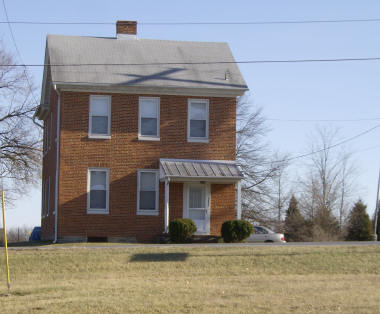
The Tollhouse as it appears
today near the intersection of South Seton Avenue and the Old
Emmitsburg Road |
During the afternoon of June 27th, a part of General George
Armstrong Custer’s Brigade of Michigan Cavalry was encamped just south
of Emmitsburg on the old tollgate, before heading toward Hanover on
the following Monday. George Custer was only 24 years old when he was
promoted to Brigadier General in Frederick. He had replaced General
Joseph T. Copeland as commander. General Custer had scouted the
Emmitsburg area and hired a local resident by the name of Jim
McCullough to guide Custer around the Emmitsburg area.
An article originally published in the Emmitsburg Chronicle on
August 31, 1951, stated that “On Saturday the 27th day of June, two
regiments of Michigan cavalry camped a mile south of Emmitsburg on the
Tollgate held the advance of Kilpatrick's division. They were armed
with the deadly Spencer repeating carbines and looked like they could
fight. They stayed until Monday, when the division arrived and they
all marched to Hanover, Pa. They were guided by Jim McCullough, an
Emmitsburg soldier boy, who was counted as one of the best scouts in
the army.”
Dr. Thomas C. Moore of Mount Saint Mary’s later recalled: “The
first large body that passed near the College was the 6th Michigan
Cavalry. They jogged along, four abreast, many of the weary riders
leaning forward, sound asleep on the necks of their horses. Many of us
sat on the fences along the road watching and listening to their
sayings. We naturally looked upon the men as sheep led to the
slaughter, and we were not a little surprised when we overheard two of
them closing a bargain on horseback with the remark: 'Well, I will
settle with you for this after the battle. Will that suit you?' The
other party readily assented. The whole period of life is treated as a
certainty, even by men going into battle.”
General Custer’s men had made their camps on the grounds of the St.
Joseph’s House. Joseph Brawner, the field manager had the cutting
machine ready to cut down the clover that covered the fields to store
in the barn loft. He would carry out the task of cutting down the
clover in the meadows that surrounded St. Joseph’s. As the 5th
Michigan Cavalry made their quarters for the night, they let their
horses graze in the fields. Once sunrise came on Sunday morning of
June 28th, the fields were barren and nothing was left of the clover.
William O. North of the 5th Michigan Cavalry gave the Sisters of
Charity a memo that stated: “Joseph Brawner was entitled to pay, for
16,000 pounds of hay being the amount consumed and destroyed by the
5th Michigan Cavalry while quartered on the grounds of the Saint
Joseph’s House on the night of June 27, 1863.